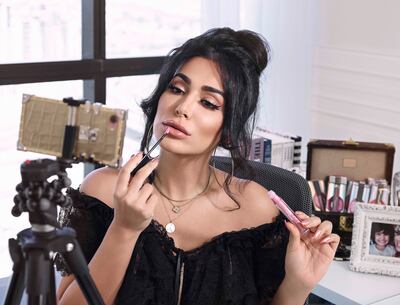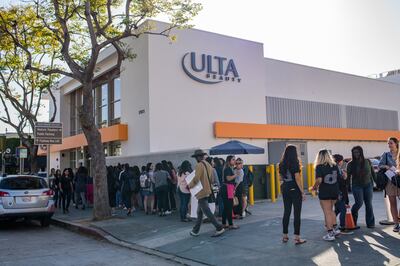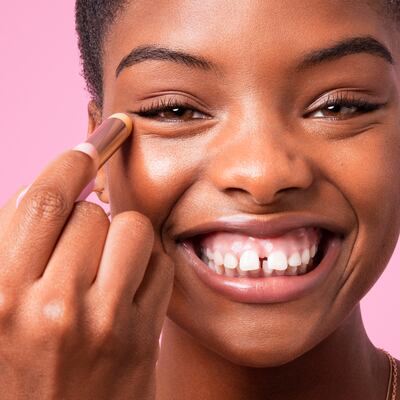
The Business of Fashion
Agenda-setting intelligence, analysis and advice for the global fashion community.

Agenda-setting intelligence, analysis and advice for the global fashion community.

Beauty customers can be fickle.
The pandemic has created new opportunities for many makeup and skin care brands as online sales have surged. But keeping those new consumers is harder than ever. Amid a constant flow of new products, shoppers are being trained to look out for the next big thing instead of developing beauty routines that might last a lifetime.
The average customer retention rate for beauty brands is about 23 percent, or 1.6 orders per customer, according to a report by data analytics company Metrilo.
“The competition is increasing,” said Michael McNeil, Huda Beauty’s senior vice president of global marketing and communications. “Another eyeshadow palette is a click away — and it’s still great quality, it’s another wonderful brand.”
ADVERTISEMENT
The brands poised to succeed put a premium on loyalty, even if the odds are stacked against them. BoF spoke to brands, retailers and experts about how to keep customers coming back for more.
Sell a brand, not a product
Even in a market saturated with new products, brands have to find a unique offering or risk being forgotten.
“You have to make sure that, at the essence of whatever it is that you’re selling, there’s something for people to really care about,” said Marcia Kilgore, founder of Beauty Pie.
You have to make sure that, at the essence of whatever it is that you’re selling, there’s something for people to really care about.
Beauty Pie operates as a buyer’s club akin to the Costco model, where visitors pay a monthly or annual membership fee to gain access to products. The brand pitches itself as offering prestige beauty at low prices. It has seen membership increase 70 percent, and revenue double, since March 2020.
Beauty brands that stand for something can offer a compelling proposition to customers, who can be part of a community simply by buying a product. This is all the more relevant as consumers are more likely to shop with brands that claim to align with their values.

Huda Beauty’s founder Huda Kattan began as a beauty blogger and social media influencer before launching cosmetics and skincare, gathering a loyal following of beauty lovers. Today the brand leans into its founders blogging roots, integrating her blog into the e-commerce website. Kattan is a prolific producer of articles, videos and beauty tutorials that feature products from a range of beauty brands — not just her own. She also posts about social issues her and her followers care about.
“The key thing that we sell is really content and representation and community,” McNeil said. “We put forth a philosophy, a type of community, that we want to build, a stance on representation — and the makeup is really just the take home of that.”
ADVERTISEMENT
Deliver on the basics
That said, underneath the branding, a product has to do what it says on the tin. If a purchase under-delivers on expectations, that shopper is unlikely to ever return. However, if shoppers trust a retailer or brand, they are more likely to try new offerings as they drop.
Peach & Lily, a site that sells its own beauty lines alongside third-party K-Beauty brands, can take months to decide whether stocking a new brand is worth it. Only 5 percent of brands that it looks at make the cut onto the website, said founder Alicia Yoon.
“Your reputation is what matters, and when people try it, everything has to delight. That means saying no to a lot of things,” she said.
Present a friendly face
Keeping customer service in-house is a smart move, said Kristy Engels, president of Beauty Strategy Group. It helps brands with everything from product development to maintaining relationships with customers. But brands have to be prepared: it’s hard work. Today, customers’ expectations are higher than ever.
Whether a customer is reaching out to the brand via email or social media, they are really expecting an answer in under 24 hours, said Peach & Lily’s Yoon, even if that means saying, ‘I need to look into that I’ll get back to you,’ and following up later. Responses need to be helpful and relevant.
Peach & Lily has never outsourced its customer service, mainly because that often requires a standardised protocol on how to answer queries. Instead, the brand can solve any issues in a way that is best for an individual customer, whether that be swapping a product they are not happy with for something else, or providing a full return and refund.
ADVERTISEMENT
“If it’s super prescriptive, you can’t really go above and beyond,” said Yoon. “We give a lot of agency to our customer service team to actually make judgement calls … we want that [experience] to feel personalised and different for each person.”
You really have to be knowledgeable; you can’t give a customer wrong information about your product or your brand.
Increasingly, brands are seeing customers ask questions about beauty routines, different ingredients, and whether products are suitable for vegans. Customer service representatives have to be prepared to accurately answer these types of queries too, said Junior Pence, chief marketing officer at Peace Out Skincare, a skincare brand.
“People are more and more educated on what skin care is — ingredients, whether you’re clean, you’re vegan or cruelty free,” Pence said. “You really have to be knowledgeable; you can’t give a customer wrong information or misleading information about your product or your brand.”
As brands scale up, the customer service department can easily become siloed from other parts of the business. Brands should work hard to integrate the department into all areas of the company, said Emma Lawson, vice president of e-commerce at Huda Beauty. This is why the brand’s head of customer service attends all key business meetings, “to be the voice of the customer,” she said.
Invite shoppers to join the club
Belonging to a brand’s membership club can help keep it top of mind — and incentivise repeat purchasing over a period of time. For the brand, it can also provide a ton of customer data, giving insights into what your customers want while being able to personalise their experience.
Manicure brand Olive and June offers a membership programme, where, for $30 a year, shoppers get free shipping ($4.95 for non-members) and 10 percent off every order, as well as perks, like early access to new product drops and free gifts with orders.
Beauty Pie has membership baked into its business model. Different membership tiers have different caps on how much a shopper can spend each month. While it varies across its customer base, most members come back to purchase new products every couple of months, said Kilgore.
“Having a membership [means] of course she’s going to come to us first to see if what she needs is in our selection. And then after that she might go shop somewhere else,” she said.

Loyalty programmes that reward customers for shopping returning can also be a powerful retention tool, especially if shoppers see results quickly. Ulta Beauty’s Ultamate Rewards programme has 30 million members who have made at least one purchase over the last year, while 95 percent of the retailer’s sales come from shoppers who are part of the programme.
“It definitely is a big driver of our business,” said Ulta Beauty chief marketing officer Shelley Haus.
For Ulta Beauty, a priority was making the programme simple to use and easy to understand to encourage shoppers to sign up and use it regularly. Rewards customers start by earning one point for every dollar spent. But the more money a customer spends in a year, the higher their membership status and the more points they gain on purchases. Customers in the programme also have early access to new product launches.
Ulta Beauty uses the data it gathers from its rewards programme to tailor each customer’s experience with content, offers and product recommendations.
Become your customer’s BFF
Brands need to foster emotional connections with their customers, said Mintel beauty analyst Samantha Dover.
“It’s about ensuring that your tone of voice and your communication with your customer feels like you care about them,” she said, pointing to Glossier as an example of a brand that excels in this space. “They speak to their customers like they’re their friends.”
Listening to customer feedback and using that to inform strategy is important. Brands also need to make sure they’re communicating with their customers where they are, added Dover. Increasingly that’s on their phones, whether it be on Instagram, Tiktok, Whatsapp or text.

Peace Out Skincare rolled out text messaging in July 2020, sending shipping updates on recent orders and checking in with shoppers a few weeks after they received their order to ask how they like the product. Customers engaged most with texts about new launches and would often reply to the brand with questions about skin concerns or product ingredients. After just six months, SMS communication drives 11 percent of the total business revenues. Pence, the brand’s chief marketing officer, anticipates this year SMS revenue will more than double. Today, 82 percent of Peace Out’s direct sales happen on a mobile device.
“It became kind of a juggernaut for us in terms of selling our products and communicating with our consumer about our products,” said Pence.
The brand is careful to tailor its tone over text depending on the customer. “Talking to a Gen Z consumer is very different than talking to a 40 plus consumer that is buying retinol for wrinkles,” said Pence. “So we speak in very different ways through SMS to our consumers.”
Give shoppers something they can’t get elsewhere
For brands that wholesale, they need to give shoppers a reason to come directly to their own site instead of a retail partner. This can be challenging, especially if retail partners offer perks like free shipping or free samples.
Huda Beauty always drops its new products on its own website first. Visitors will also find a range of stuff they cannot get anywhere else, from additional shades of a new palette, to Huda Beauty merch, like headbands, pyjamas and slippers similar to those Kattan wears in her tutorials and videos. The brand also offers the option to personalise bundles or buy beauty kits with multiple products for a discounted rate.
THIS WEEK IN BEAUTY
L’Occitane files for bankruptcy. The American division of the luxury cosmetics company filed for Chapter 11 protection.
Coty consolidates manufacturing operations. After operating over capacity for the past few years, the company plans to close its fragrance manufacturing site in Cologne, Germany.
Harry’s Labs launches new haircare brand. Headquarters, focused on scalp care, is the latest innovation from the Harry’s Inc brand incubator.
Interparfums beats analyst expectations. The group, which makes fragrances for Coach and Jimmy Choo, reported full-year revenue of €367.4 million ($445.6 million) following a boost in the US sales.
Condé Nast to launch Allure beauty store in NY. The beauty magazine will open up an experience-led brick-and-mortar location on Lafayette Street later this year. Alongside shopping, the editorial team will host regular events, tutorials and masterclasses.
Beauty brand incubator Maesa names new CEO. Gianni Pieraccioni, a former Coty executive, will take the helm on February 1. Founder and current CEO Julien Saada will transition to chairman and chief strategy officer.
Boohoo buys a beauty business. The ultra-fast-fashion group is leaning into its beauty ambitions with its Debenhams acquisition. The department store, which sells brands like Chanel and Benefit, has 6 million beauty customers and 1.4 million members of its Beauty Club.
Sam Visser is Dior Beauty’s new US ambassador. The makeup artist who’s worked with the likes of Bella Hadid and Kendall Jenner will collaborate on digital, editorial and red carpet projects for the house.
Powered Brands wants to build a new beauty conglomerate. Following a successful public debut, the female-founded special purpose acquisition company (SPAC) says it’s looking to acquire assets worth between $800 million and $1.5 billion.
Demand for the drugs has proven insatiable. Shortages have left patients already on the medications searching for their next dose and stymied new starters.
The company reported a long-awaited lift in net sales in its third quarter results, with increases from skincare leading the way, but clouds persist over its China recovery.
As awareness grows about the perils of sleep deprivation, beauty and wellness brands are flooding the market with an array of products to cash in on the booming opportunity.
Going public is usually a pivotal moment in a company’s history, cementing its heavyweight status and setting it up for expansion. In L’Occitane’s case, delisting might be a bigger conduit for growth.